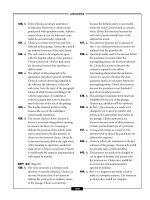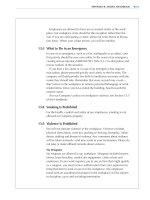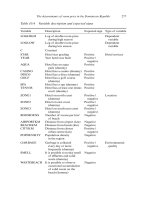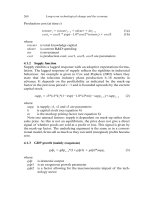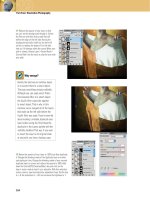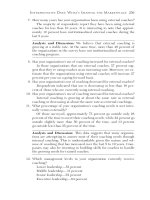Hiring the Best and the Brightest phần 10 pot
Bạn đang xem bản rút gọn của tài liệu. Xem và tải ngay bản đầy đủ của tài liệu tại đây (402.94 KB, 38 trang )
252 Hiring the Best and the Brightest
• Touch base regularly outside of your weekly meetings—informally
check in to see how things are going, get and give feedback. Make
yourself available as a resource and coach.
• At the end of 90 days, whether your company requires one or not, give
a performance review. Schedule a time to sit down and talk. Write up
something, even a page review. Provide an abbreviated version of any
annual or midyear formal performance review you do companywide.
Listen to feedback about how the new hire thinks he or she is doing,
and which areas still need to be worked on, how your relationship is
working, and what both of you can do better.
Setting up your new hire for success, especially during the first 90 days,
will go a long way, but it’s still not happily ever after from here. Employee
and employer relationships are like wonderful marriages. They need continu-
ous attention and care. The next chapter discusses in detail the seven Cs of
keeping your great talent now that you have it. Your mission, should you
decide to accept it, is to motivate, energize, and develop. May the force be
with you.
Chapter 16
Retention Tool Kit
AFTER THE INITIAL ENTRY INTO
an organization and the honey-
moon period is over, the kinds of retention tools and strategies you use will
influence whether your great new hires stay or go. Over the years I’ve devel-
oped what I call the seven Cs. Whether you have thirty people or 30,000,
these can be effective influences on keeping the talent you want and keeping
them motivated, happy, and developing. These overlap, interplay, and inter-
sect. Optimally, these seven Cs are pervasive in a company’s daily manage-
ment practices and philosophies.
THE SEVEN C
S
1. Core Values and Culture
When I asked Paul DiNardo, managing director of the High Technol-
ogy Group, Investment Banking Division at Goldman Sachs, how his firm
creates a culture that keeps people there and high performing, he said most
eloquently:
The most important aspect of any corporate culture is the behavior it fosters.
At Goldman Sachs, this is embodied within our core business principles, the
254 Hiring the Best and the Brightest
first of which is, Our client’s interests always come first. Everything else
derives from that unambiguous commitment. Within that context, we strive
daily to create and maintain an environment of teamwork and mutual
respect, not merely because we believe that it is appropriate, but because we
believe that in the increasingly complex and global investment banking
industry, it is the most effective way to serve our clients. This combination
of a supportive work environment and unwavering client commitment en-
ables our professionals to best serve their clients and maximizes the opportu-
nity for both professional success and personal enjoyment in their jobs.
Core values and culture are inextricably linked. Simplistically, values
are the foundation of what you or your company holds dear and are the
underlying principles that guide you. Culture is a system of shared values
and norms that define appropriate attitudes and behaviors for its members.*
Whether you’re an established company and have defined core values
and culture, or a start-up that’s beginning the dialogue, either bottom up or
top down, knowing your values and culture and living them authentically
will create resilient bonds among people and with the company. It also serves
a purpose in attracting and screening candidates. Values and culture are in-
credibly powerful levers not only for attracting the people you want but also
for keeping them moving together and feeling a sense of community and
belonging with the company and their colleagues.
Over time, the core values don’t change markedly, although they may
evolve. They are guideposts through the tsunamis and sea changes along the
way.
2. CONNECT AND INTERACT FREQUENTLY
Connecting people to people, and people with the company, at its best
is planned happenstance. Connections happen because of all sorts of reasons,
for example, because the company goes out of its way through its communi-
cation or rewards system to help its employees feel part of a higher purpose,
part of building a great company. They happen because an employee enjoys
and finds fellow workers interesting. Connections result from open lines of
*Tushman and O’Reilly, Winning Through Innovation, Harvard Business School Press,
1997.
Retention Tool Kit 255
communication—people know what’s going on and therefore can connect
what they are doing to the bigger picture. A powerful influencer connecting
people to each other and the company is frequent interaction, across levels,
groups, and locations.
Structured and unplanned interactions can build common ground and
purpose; generate excitement, enthusiasm, and energy about coming to
work; keep people feeling a part of something bigger; and keep employees
updated on business wins, challenges, problems, and how things are going.
You’re also sending an implicit message that you care about people as human
beings, collectively but also individually.
People can feel connected to each other, to their team, to the company,
to its products or services, to its vision of where it wants to go, and to a
higher purpose. People who are connected to each other are more likely to
take each other into consideration when they make decisions. They are more
likely to stick it out even if the going gets rough, because they don’t want to
let their friends down. They are more likely to give every ounce of energy to
help the company win because they feel a part of the company’s direction
and goals. Sometimes, through sheer brute force, they can pull off something
astounding—something no one else has done or thought they could do—
because they feel connected to their team and their CEO and manager.
Interactions take place formally and informally through activities, ges-
tures, events, and communication. We’ve read about the lengths to which
companies go to connect senior executives and employees and to create com-
mon goals. There are coffee and wine tastings, orientations with senior man-
agers in dunk tanks, open mike programs, company clubs and sports teams,
inspirational speakers, book clubs, and money set aside for each employee to
spend on items for themselves or colleagues to enjoy—such as foosball tables,
wind chimes for the lobby, rafting trips, and charitable causes.
In my current role at Stanford, I host a fun day once a quarter where
we may see a movie, go for ice cream, or have a BBQ at my home. At the
end of one year and before developing plans for the next, we do a retreat
where we celebrate successes, talk critically about the past year-in-review,
and brainstorm plans for the future. We connect on many levels. When
working in marketing for Dole Packaged Foods, as we were introducing new
frozen desserts we enlisted the help of colleagues through impromptu taste
testing. We laughed together, dripped our desserts together, and debated
256 Hiring the Best and the Brightest
what we liked and didn’t about each texture and flavor. We connected and
helped produce a better product.
These are activities, gestures, and events that help connect people to
people—one person at a time—and connect people with the company.
Communication is such an important interaction that it deserves its own
focus.
3. COMMUNICATE LIKE YOU MEAN IT
Beyond activities, gestures, and events, companies facilitate connected-
ness through communication. Companywide internal communication ini-
tiatives such as an employee intranet or newsletter have worked over the
years and still do. Beyond these, personal communication by managers to
their staffs and by the company executives to employees not only keeps
people connected, it keeps them informed, productive, and happy: They
feel like they are insiders, know where the company is going, and have the
information they need to do their jobs as best they can. Examples of effective
high-touch communication are all-hands meetings, weekly conference calls
with direct reports, or customized e-mail distribution lists to share informa-
tion or solicit input.
Most employees really want to hear about their company’s vision, strat-
egy, short- and long-term priorities, and how the company is doing. They
are invested in the company; they are engaged, giving their time, talent, and,
sometimes it seems, much of their lives to work. People have an innate need
to hear from their leaders about what’s on their minds, and to ask, Do they
walk their talk (do their words and deeds match?), are they genuine, do they
care about me as a person, are they real, and do I believe in their ability to
lead the company? This is not only at the CEO level but from their boss’s
boss on up to any senior manager that is going to influence the direction
and performance of the company (Figure 16-1).
As a side note, I’ve coached incredibly capable executives over the years
who failed to fulfill their potential of greatness because they were ineffective
communicators. Communication is a learned skill, but its genesis must be
the belief that it’s important and the authenticity to say it because you mean
it.
Beyond the executives, the company as a whole needs to communicate
like it cares. Usually there is an internal communications or HR group that
Retention Tool Kit 257
Figure 16-1. The Seven Cs.
Culture and Core Values
Connectedness
Commitment to People
Communication
Career Development
Continous Learning
Compensation
Integrated, these seven principles can help you
develop and keep your talent
in good times and challenging ones.
handles this responsibility. In a start-up, perhaps it’s the ‘‘keeper of the cul-
ture,’’ the CEO. Traditional means of internal communication initiatives
that still work effectively today are HR manuals, newsletters, quarterly meet-
ings, copies of the CEO’s or executives’ speeches, suggestion boxes, nomina-
tions for appreciation awards, and remarks on the state of the company at
an event such as a picnic or a holiday party.
New ideas we’re seeing include town hall meetings, suggestion or ap-
preciation boxes, culture or strategy summits, radio hours (presentations
supplemented with open discussion on live issues between company leaders
and employees), weekly online chats with a different senior manager each
258 Hiring the Best and the Brightest
time, and employee rap sessions. There are also outstanding examples of
companies’ imaginative employee Web sites and corporate portals.
The better intranets are effective because they provide the basics, such
as information on upcoming events, the company stock price, welcomes to
new employees, benefits forms, press releases, HR policy manuals, a com-
pany directory, and job listings, among others. As important, they are also
interactive, always changing, easy to navigate, and a favorite destination that
employees want to check out. They keep content fresh, relevant, and inter-
esting.
Companies like PricewaterhouseCoopers and CEO Express’s Enter-
priseExpress are experts in the arena of intranets, extranets, and company
portals:
• PricewaterhouseCoopers (www.pwcglobal.com): Its extensive range of
offerings includes audit, assurance and business advisory services, busi-
ness process outsourcing, corporate finance and recovery services, global
HR solutions, management consulting services, and global tax services.
The firm works with clients to select and implement the components
that will further your e-business initiatives, from Web site development
to the design of Web applications that are fully integrated with your
existing systems.
• CEO Express (www.ceoexpress.com or www.ceoexpress.com/html/in-
exintraextra.htm): Enterprise Express provides private-label intranet and
extranet products for companies wanting to communicate with employ-
ees and clients. Its corporate portal product provides a unique software
and service hybrid that incorporates technology and human intellect.
With their business content on the Web and a simple yet powerful
development and administration interface that virtually anyone in your
organization can use, you can launch a great site quickly. Features in-
clude launching a site—templates, multiple editing levels, and so on;
updating and managing a site—multistate options, revision tracking
and control, automatic content release, and so on; organizational con-
siderations—multiple platform deliver, single site as intranet, Web site,
and extranet, hosted ASP or behind-the firewall solution, and so on.
4. CREATE CONTINUOUS LEARNING OPPORTUNITIES
There are numerous books and resources that delve into the gamut of
learning organizations, training, company universities and campuses, busi-
Retention Tool Kit 259
ness simulation tools to help people acquire new skills and knowledge
quickly, mentoring programs, and distance learning. I discuss here why it is
important to create continuous learning opportunities and a few suggestions
of how that might look.
Great companies use continuous learning as a retention tool—keeping
their employees’ development on the front burner—but they also know
pragmatically that employees who continuously learn use that new learning
in their jobs on behalf of the company.
Talented employees want the opportunity to keep on learning, to feel
like they are growing and developing, and enriching themselves personally
and professionally. They want both the developmental opportunities and the
one-to-one learning, for example, their manager giving feedback on perform-
ance. They may also need some structured development, additional learning
in soft and hard skills so that they can do their jobs better and become more
competent. A soft skill, for example, is public speaking. A hard skill may be
learning how to do develop a marketing plan or a budget.
I keep saying learning versus training because, bluntly, dogs are trained,
people learn. You’re probably also beginning to see the title chief learning
officer for the top HR executive in training and organizational development.
Continuous learning is a basic human need and although not a deal-
breaker—the reason someone would leave the company—it is a high-impact
retention tool. It’s also a two-way deal. The company can provide opportu-
nities for learning but ultimately it takes initiative and commitment from
the employee—the motivation and energy to learn. The better companies
I’ve worked with offer the tools and resources to support the employee’s
development, then let the employee do his or her part. This could be in both
informal and formal ways. Some proven ideas that work well are:
• A learning center open 24/7 and a manager on site during regular office
hours. The center would offer books, workbooks, videos, audiotapes;
bookmarked and linked Web sites and other online materials for gain-
ing new skills or knowledge.
• A company university. Industry experts, leading academicians, and
company stars are used to teach courses. There’s a curriculum, books,
tests, classroom participation, a certificate or celebratory event upon
graduating or completion of the course or set of courses, as in school.
TEAMFLY
Team-Fly
®
260 Hiring the Best and the Brightest
Courses include one-time workshops and short courses lasting a few
days to extensive ones lasting several weeks.
• Noontime workshops facilitated by an expert or interesting speaker on
a particular topic such as performance management, project manage-
ment, high-performance teams, work-life balance.
• Executive education courses at top business schools. Almost all of the
top-tier schools offer nondegree courses for managers. Their school
Web sites would have application information, schedules, and program
descriptions. You could selectively choose to send high potential manag-
ers to offerings ranging from strategic HR to supply chain management,
finance for nonfinance managers to longer ‘‘mini’’ MBA type programs
that are residential and last for 3-6 weeks.
Two standout resources are Ninth House Network (www.ninthhouse.
com), an e-learning company that simulates everyday situations that come
up in work—kind of like going to business school but you can learn while
on your PC. Ninth House Network is designing, developing, and deploying
a comprehensive e-learning solution for today’s leading businesses. They ef-
fectively integrate cutting-edge content, technology, and services into a com-
prehensive learning solution that addresses today’s critical business issues.
Solutions include instant advice, eSeries, measuring results, technology, ser-
vices, and learning channels that focus on business solutions.
Pensare (www.pensare.com) is a leading e-learning company that cre-
ates business knowledge communities which offer content from renowned
business and academic thought leaders. Within the communities, profession-
als share best practices, leverage practical tools, and engage in strategic dis-
cussions to solve critical business problems. Currently Pensare offers business
content from top-tier business schools and industry experts in such program
areas as e-commerce, finance, marketing, information management and op-
erations, management, strategy, leadership, entrepreneurship, customer rela-
tionship management, and global business.
Beyond structured learning opportunities, employees learn perhaps best
by hands-on experiences:
• Filling in for a colleague in a different job who is on maternity leave or
sabbatical.
• Serving on a task force, for example, an engineer contributes on the HR
Retention Tool Kit 261
policy committee, a director of finance sits on the social committee, an
HR manager is on the new technology integration team.
• Handling an in-place assignment. This involves the employee staying
in place but picking up additional responsibilities within the group,
such as media interviews or doing some recruiting or mentoring. The
old-fashioned term for this is cross-training. It is good because it gives
you backup if someone is out.
Through all of these learning opportunities, employees tackle new chal-
lenges, and continue to add new skills, abilities, and knowledge to their
repertoires. This all impacts how they feel about the company and their
work, which in turn affects whether they stay or they go. These sorts of
things also build up credits (versus debits) for you so that an employee is
more likely to stick through tough times with you and not be tempted to
talk to the next headhunter who calls.
5. CARE ABOUT CAREER DEVELOPMENT
Continuous learning gives employees more confidence and a broader,
deeper repertoire of skills, abilities, and knowledge. Ideally, the employees
then use their newfound learning to perform better in their current jobs or
make a career-enhancing move within the company. Career enhancing be-
cause gone are the days of the pyramid—top talent moving up, up, up,
vertically. Career enhancing or broadening is commonplace today and for
the foreseeable future. This means people experiencing a diversity of func-
tions and areas, like a portfolio of jobs and responsibilities, throughout one’s
career.
Career development engenders employees who are more committed,
loyal, and productive. In the best-case scenario, the employee owns his or
her career, but the company provides resources and support to move it along.
A helpful resource is Careerdiscovery.com, founded by Tim Butler and
James Waldrop of the Harvard Business School. Among their respected body
of work, they have identified some character traits that get in the way of
success. Their BCII (business competencies and interests inventory) is used
at many business schools to help MBAs in their own career and self-
assessment.
262 Hiring the Best and the Brightest
6. COMMIT MANAGERS TO PEOPLE AND MAKE SURE
THERE’S ACCOUNTABILITY
If people are a priority, managers up to the CEO need to believe it,
embrace it, and show it. From the top down, managers who show their
commitment to people and are accountable for it make a significant impact
on motivating and energizing their workforce. Many companies include in
their managers’ objectives core people issues and challenges such as recruit-
ing, developing, and retaining. They put teeth into the objectives by making
a commitment to people issues as part of their performance evaluations.
They unequivocally convey that people are important. People issues like
managing performance, building morale, and listening to employees are par
for the course and are absolutely expected. And they allow their managers
the time to spend on it; it’s not just work on top of everything else they have
to do; it is valued work.
Using 360-degree feedback is also useful. We see 360-degree feedback
happen when you solicit feedback from a person’s boss, staff, and peers. A
manager who consistently falls short, especially to his or her staff, needs
coaching. If HR is doing exit interviews with employees and there are themes
emerging for a particular manager, that manager needs the feedback and the
action items and resources for changing. The company needs to make the
manager accountable for results.
7. COMPENSATE WITH TANGIBLES AND INTANGIBLES
Total compensation in the broadest sense is the sum total of everything
that an employee receives from the company, the job, the environment,
colleagues, and so forth. Along this line of thinking, all six of the retention
tools discussed here are part of compensation—both tangibles and intangi-
bles. For a refresher, Chapter 8 covers compensation fundamentals and talks
about the importance of the intangibles that really mean a lot to people
these days. If you’re doing the above, you’re already a long way on the
intangibles—living your core values and culture, giving people opportunities
to learn and develop in their careers.
Worth noting here are some of the best ways that companies use com-
pensation in the more traditional sense, and beyond base pay, to keep great
talent: incentives like stock options and bonuses; perks such as on-site child
Retention Tool Kit 263
care or exercise facilities; telecommuting; flexible hours; job shares, sabbati-
cals; job content; job titles; and good, old-fashioned recognition and praise
like a note or an acknowledgment in a staff meeting.
Words of Wisdom
John Helding, former senior director for Worldwide Recruiting at Booz,
Allen and Hamilton, sums up the gist of this chapter with his insights on
how companies can keep their talent:
The key is to treat all employees as customers rather than as a resource (one
of the reasons I think HR is a misnomer). In today’s marketplace for talent,
any company, new or old economy, is offering a product—a career or some
part of a career. Candidates are consumers shopping for the best career
offering. They are not some static resource like oil or silicon.
They make decisions and choose the career opportunity that best meets
their needs at the moment. As such, you need to analyze your career ‘‘prod-
uct’’ in the same way you’d analyze any product offering. What do they
really want?
How can your organization best supply that and do it better or differ-
ently than anyone else?
Keeping top talent is clearly in part a matter of being competitive
financially, but beyond that it’s being exceptional across the full set of em-
ployee needs or desires. Things such as a sense of community and belonging,
purpose beyond a P&L, pride in the organization, professional challenges
and growth, some control over one’s destiny. It’s the overall offering that’s
critical in having any chance of keeping at least some of your top talent. A
fixation on compensation alone just reinforces that as a deciding factor, not
to mention attracts the gold seekers to your firm in the first place. Hiring
more broadly and serving a broader set of needs not only builds stronger
professionals, but also encourages a stronger and more lasting sense of com-
mitment and loyalty. Sounds old fashioned, but then again, the dot-coms
once sounded invincible.
Recommended
Reading and Resources
Career Development/Employee Retention
First, Break All the Rules: What the World’s Greatest Managers Do Differently,
Marcus Buckingham and Curt Coffman, Simon and Schuster, 1999.
‘‘A Market-Driven Approach to Retaining Talent,’’ Peter Campelli, Harvard
Business Review, January–February 2000.
Love ’Em or Lose ’Em: Getting Good People to Stay, Beverly Kaye and Sharon
Jordan-Evans, Berrett-Koehler Publishers, 1999.
Employment Web Sites
Career X Roads: Where Talent and Opportunity Connect on the Internet, Gerry
Crispin and Mark Mehler, MMC Group, 2000.
WEDDLE’s Recruiter’s Guide to Employment Web Sites 2001, AMACOM.
Strategic Human Resources
Competitive Advantage Through People, Jeffrey Pfeffer, Harvard Business
School Press, 1994.
The Human Equation: Building Profits by Putting People First, Jeffrey Pfeffer,
Harvard Business School Press, 1998.
Hidden Value: How Great Companies Achieve Extraordinary Results with Ordi-
nary People, Jeffrey Pfeffer and Charles A. O’Reilly III, Harvard Busi-
ness School Press, 2000.
Winning Through Innovation: A Practical Guide to Leading Organizational
Change and Renewal, Charles A. O’Reilly III, Harvard Business School
Press, 1997.
Recommended Reading and Resources 265
Harvard Management Update, hbsp.Harvard.edu, 800-668-6705
Harvard Business School Publishing: Manager’s bookshelf, 800-668-6780
www.hbsp.harvard.edu
www.hbsp.harvard.edu/ideasatwork/managersite
Society for Human Resource Management
1800 Duke Street
Alexandria, VA 22314 USA
Ph: (703) 548-3440 Fax: (703) 535-6490
E-mail:
The Society for Human Resource Management (SHRM) is the leading voice
of the human resource profession. Providing education and information ser-
vices, conferences and seminars, government and media representation, on-
line services and publications, SHRM has more than 145,000 professional
and student members worldwide. The Society is the world’s largest human
resource management association.
Workforce Week
www.workforce.com
Thousands of articles, tips, forms, bulletin boards, and product listings. A
respected source of work-force management information.
Appendix A
MBA Recruiting Cost per Hire
(CPH)
MBA COST PER HIRE
Total Costs/
࠼
of Hires
Total Costs ס
• Recruiting Staff Salaries
• Image/Branding Strategy
• Collateral Materials, e.g., Recruitment Brochures, Event Invita-
tions, Flyers, Banners, Posters, Direct Mail, etc.
• Campus Newspaper Ads
• Sponsorship of School Events
• Focus Groups
• Career Fair Booth or Upgrades to Existing
• Giveaways, e.g., Career Fairs, Info Sessions, Thank Yous
• Internet Strategies
• MBA-Dedicated Web Site
• Job Posting Sites
• Re
´
sume
´
Database
• Banner Ads
• Travel and Entertainment
• Employer Information Session
Appendix A 267
• Day-on-the-Job
• Second-Round Program
• Sell Weekend Program
• Staff Travel, e.g., Campus Visits, Pre-Recruitment, On-Campus
Interviews
• Candidate Travel, e.g., Second Rounds, Sell Weekend
• Relocation Costs
• Incentives/Signing Bonuses
Note: There are many variations of cost per hire. Some include indirect
costs, such as interviewer cost of time allocated. The most straightforward
cost per hire is all program costs including HR staff dedicated to MBA
recruiting plus other direct costs.
FACTORS AND GENERAL BENCHMARKS IN CPH
Cost per hire (CPH) varies widely across industries and companies. If
you further calculate CPH by individual school, the variances could be dra-
matic. There are no comprehensive reports on industry-specific CPH, and
individual company information is proprietary. Anecdotally, here are some
observations.
Factors
CPH depends on factors such as where you are in your MBA recruiting life
cycle—a start-up stage or a mature, fine-tuned phase; your company location
in proximity to your target campuses; the competitive demand and level of
aggressiveness for your desired candidates; how elaborate or basic your re-
cruiting plans; how effective you are.
ABenchmark
A good benchmark is how your MBA CPH compares on a relative basis to
your other recruitment sources for managerial/exempt talent. In general, you
are doing well if your MBA CPH is even with or lower than other sources,
for example, executive recruiter fees, employer referral finder’s fees, print or
online advertising, Web site job postings, career fair participation.
268 Appendix A
Average Range
Most companies will have MBA CPHs between $5,000 and 25,000. The
bottom of the range may be a popular high-technology company; midrange
would be a consumer products company; top of range may be a consulting
firm.
Low/High
The total range of CPH I’ve seen is $1000–60,000. The low was a sexy local
Net start-up; the high was an investment bank.
Appendix B
Other MBA Recruiting Metrics
# On-Campus Interviews (OCI)
Second-Round Interview Ratio ס Call back 25–20%
# Second-Round Interviews (SRI)
# On-Campus Interviews
OCI to Hire Ratio ס 12–14 Interviewed to 1 Hire
# Hires
# Second-Round Interviews
SRI to Hire Ratio ס 4–6 Call backs to 1 Hire
# Hires
# Offers
Offer Rate ס 25–50%
# Second-Round Interviews
# Hires
Yield ס 25–50%*
# Offers
*0–25% yield is subpar
26–50% yield is good
51–75% yield is excellent
76–100% yield is superb
TEAMFLY
Team-Fly
®
Appendix C
BERTELSMANN
Joining Bertelsmann as an MBA
Bertelsmann is a complex, multifaceted organization. On the one hand,
it is an established, professional media company with leading positions in
almost every field of media. But Bertelsmann is also highly decentralized in
structure, composed of many hundreds of independent businesses that,
taken together, form a network of opportunity for the entrepreneurially
minded MBA. In short, Bertelsmann combines the feel of unlimited possi-
bilities that a start-up can offer with the proven standards of a globally active,
powerful corporate structure.
Your new colleagues and our entry-level programs for MBAs reflect Ber-
telsmann’s diversity. We employ individuals with high potential who display
a very specific pattern of talents and interests. They come from various back-
grounds, for example, the media and Internet industry, professional-services
firms including consultants and investment banks, or entrepreneurial busi-
nesses they have created themselves.
In order to help these people achieve their career goals and ambitions,
we tailor our developmental activities to the individual as much as possible.
Here are two examples of the many ways MBAs can join Bertelsmann:
Appendix C 271
Our Global Junior Executive Group
Every year up to ten people with strong entrepreneurial potential and
various educational, personal, and professional backgrounds are accepted
into our Global Junior Executive Program. The program has an interna-
tional scope—members will have a home base either in New York or in
Europe and have the opportunity to work in many different business envi-
ronments.
You will work on projects, gain both operational and strategic experi-
ence, and learn how we do things—and how we became one of the world’s
most admired companies (Fortune, 1999)—from both the creative and busi-
ness side. You will enjoy hands-on responsibility, from strategy and design
all the way to the concrete implementation of ideas and projects. You will
develop a network across the entire Bertelsmann organization. After you
have completed the program, you will find yourself prepared to soon assume
responsibility for a business operation.
The program is under the aegis of Dr. Thomas Middelhoff, CEO and
Chairman of the Board of Bertelsmann AG. You will meet with him and
other members of the executive board regularly to discuss developmental
issues—your own development as well as that of the Bertelsmann group.
The foremost prerequisite is your entrepreneurial spirit: If your aca-
demic track record, your professional experience, and your personality point
clearly toward a career in management and leave no doubt that you will
quickly rise to the top of one of our companies or divisions, then please
contact us.
Corporate and Business Development
Corporate Development at Bertelsmann means developing future op-
portunities, preparing strategic decisions, and coordinating initiatives across
the businesses and divisions. You will quickly get a feel for the media
world—and the broad picture. This is the place where many important cor-
porate policy initiatives originate and are later put into practice, and where
strategic alliances are forged and ideas for new businesses are developed. You
will directly help to shape the future of Bertelsmann.
Working in Corporate Development means being a part of an interna-
tional, dynamic, fast, and flexible team. Currently, Bertelsmann offers such
positions on a corporate level in New York and in Germany, as well as on a
divisional level in Munich and New York (Bertelsmann Book Group, Ran-
272 Appendix C
dom House, BMG Entertainment), Luxembourg and London (CLT-UFA),
Hamburg and Paris (GrunerםJahr Newspaper and Magazine Business,
BeCG—Bertelsmann eCommerce Group), and Guetersloh (New Media).
As the ideal candidate, in addition to an advanced degree from a leading
business school, you will also have a distinctive ‘‘consulting’’ profile with
the relevant experience and mindset. Your analytical skills, as well as your
communicative abilities, must be outstanding. And—in order to help us
build new businesses—you are highly creative.
Training
We believe in the principle of ‘‘learning by doing.’’ You will work with
an extremely high level of autonomy from the very first day. Learning at
Bertelsmann means autonomy and responsibility, access to successful role
models and meritocracy. Custom-designed development programs (orga-
nized both internally and externally with some of the leading business
schools, including Harvard and MIT from the United States and INSEAD
or IMD from Europe) and other intensive training opportunities are offered
to help you develop your leadership skills and to become totally familiar
with the Bertelsmann structure and culture.
Networking events with many of our most senior executives at Bertels-
mann take place every year and include all MBAs in the strategic discussions
of the firm.
How to contact us: www.zm.bertelsmann.de/en
CHARLES SCHWAB & CO., INC.
Management Associate Program
The Management Associate Program is a seven- to ten-month develop-
ment and matriculation program designed to provide functionally directed
exposure to Charles Schwab & Co. The Management Associate participates
in one 6-month headquarters-based project that offers project management
responsibilities, leadership development, business analysis training, and tech-
nology skill building.
An optional 3-month rotation is also available to provide additional
Appendix C 273
exposure to a different enterprise. The associate will have an opportunity to
work with longstanding Schwab employees, leaders, and senior manage-
ment. In addition, participants receive structured training throughout the
program. At the end of the program, the goal is for participants to move
into managerial positions throughout the company.
Qualifications
• Master’s Degree: emphasis in finance, marketing, systems, operations,
or human resources desirable
• Five plus years of business experience, with at least two years’ experience
working in a fast-paced environment
• Demonstrated project management capability emphasizing teamwork,
strategic thinking, and results-driven implementation
• Excellent quantitative/analytical capabilities, superior communication
skills, and PC aptitude
• Interest in financial service industry
• Strong customer service skills
• Foreign language fluency a plus
L’ORE
´
AL USA
Marketing Assistant
Job Profile
The Marketing Assistant will be hired and placed in a New York head-
quarters brand marketing assignment with L’Ore
´
al USA. The Marketing
Assistant will be assigned to a specific division of L’Ore
´
al, which may be
within the Hair Color, Hair Care, Styling, Treatment, Fragrance, Cosmetics,
or Sun Care Category.
Key Brand Marketing Responsibilities
Promotion
• Tracks and analyzes past activities, competitive programs.
• Executes selected projects.
274 Appendix C
• Tracks spending.
• Proofs all bluelines/mechanicals/promo order forms/sell-sheets/pricing
sheets.
Advertising Media
• Tracks and reconciles spending.
• Routes and reconciles estimates.
• Prepares monthly budget reconciliation for Finance.
• Tracks competitive spending.
• Participates in evaluation of promotional advertising.
• Participates in meetings with Agencies.
Sales
• Develops understanding of sales function, marketplace, and trade via
sales training, in-market experience.
• Tracks account performance.
Market Research
• Analyzes data (Nielsen).
• Coordinates project material preparation with Creative Services, Labs,
etc.
Finance/Forecasting
• Drafts monthly brand forecasts.
• Prepares monthly budget reconciliation for Finance.
Manufacturing
• Traffics all documentation that relates to cost estimates, etc.
• Coordinates projects feasibility.
• Manages key dates schedules.
Packaging
• Traffics all packaging-related materials.
• Proofs bluelines, mechanicals.
Language Skills
• Foreign language skills a plus.
Appendix C 275
Computer skills required: Microsoft Office Package
Interested candidates should send re
´
sume
´
with cover letter to:
Corporate Human Resources
575 Fifth Avenue
34th Floor
New York, NY 10017
Appendix D
Candidate Evaluation Worksheet
School: Date:
Interviewer: Extension:
Position: Career Ⅺ Summer Ⅺ
Poor Excellent
Company-Specific Criteria
Leadership/Management Potential 1 2 3 4 5
Intellectual/Analytical Horsepower 1 2 3 4 5
Interpersonal/Communication Skills 1 2 3 4 5
Job-Specific Criteria
Relevant Work Experience 1 2 3 4 5
Technical Abilities 1 2 3 4 5
Fit with Team 1 2 3 4 5
Recommend: Ⅺ Invite Back Ⅺ Refer to Other Dept:
Ⅺ Hold for Now Ⅺ Don’t Pursue
Comments:
Final Status:
Ⅺ Follow-up Interview Date: Ⅺ Group/Job:
Ⅺ Offer Ⅺ No Offer Ⅺ Accept Ⅺ Decline/Why?
